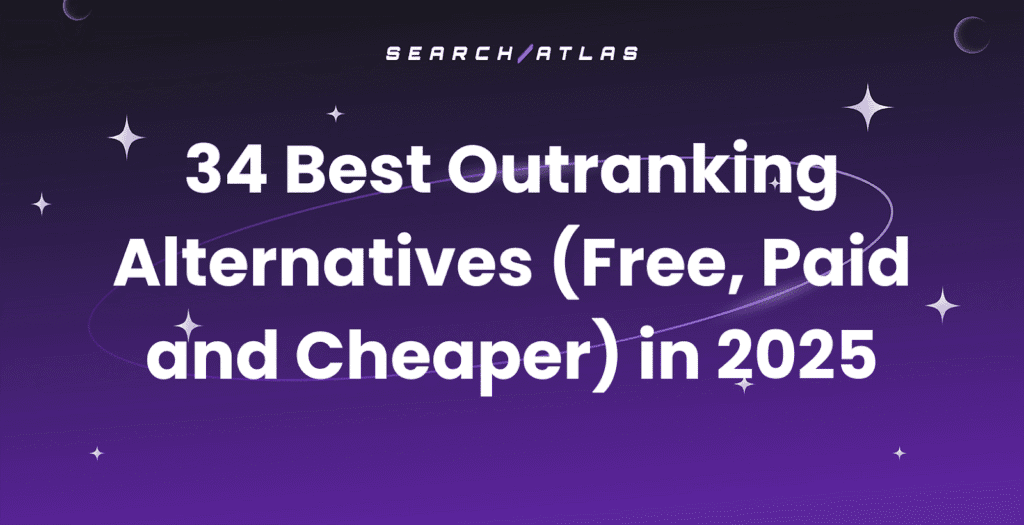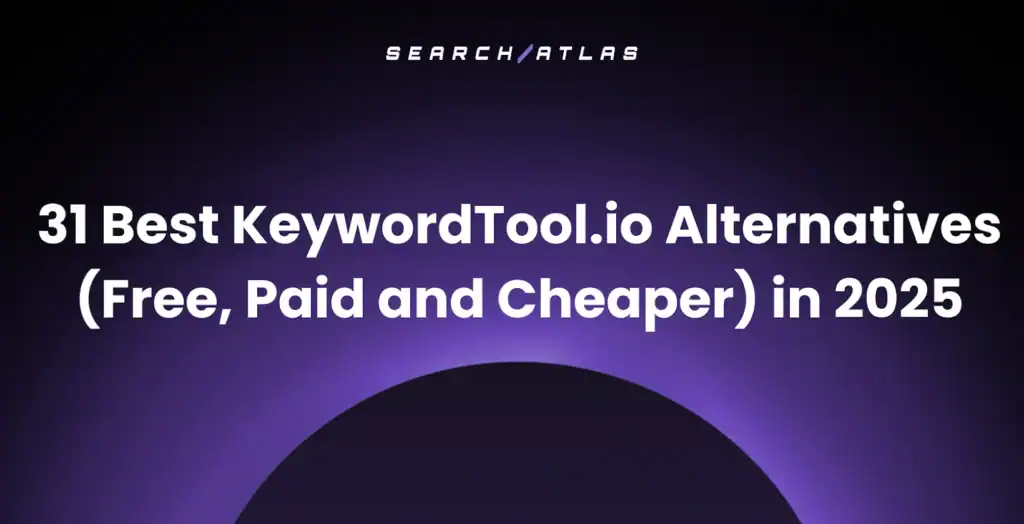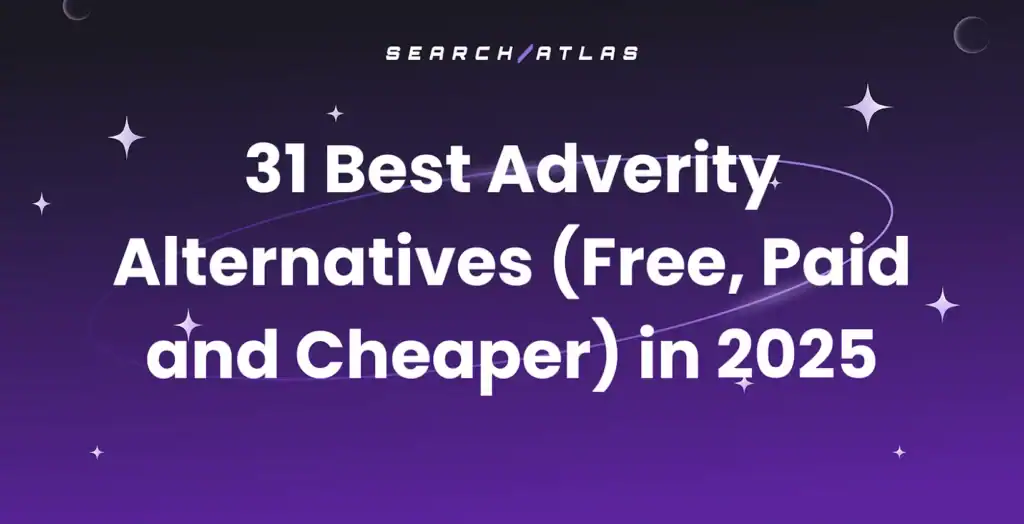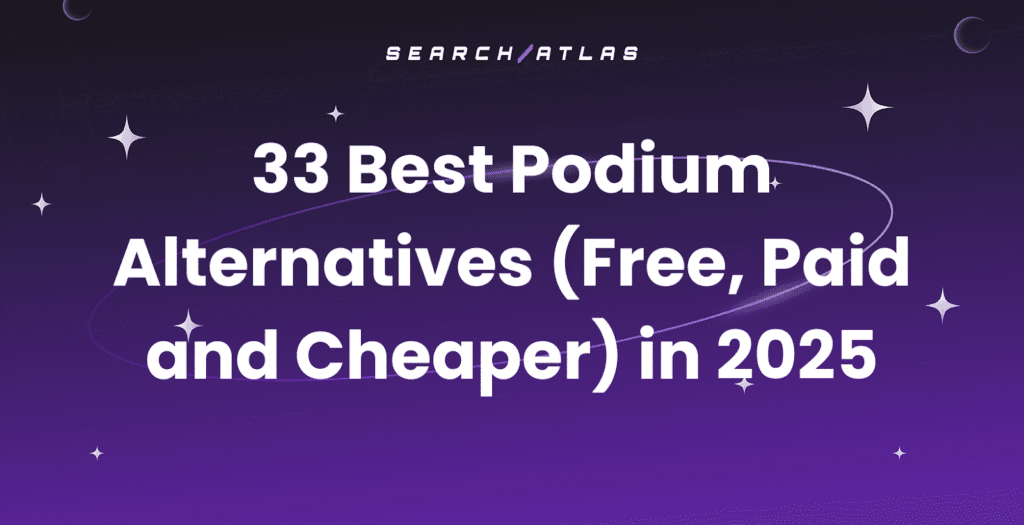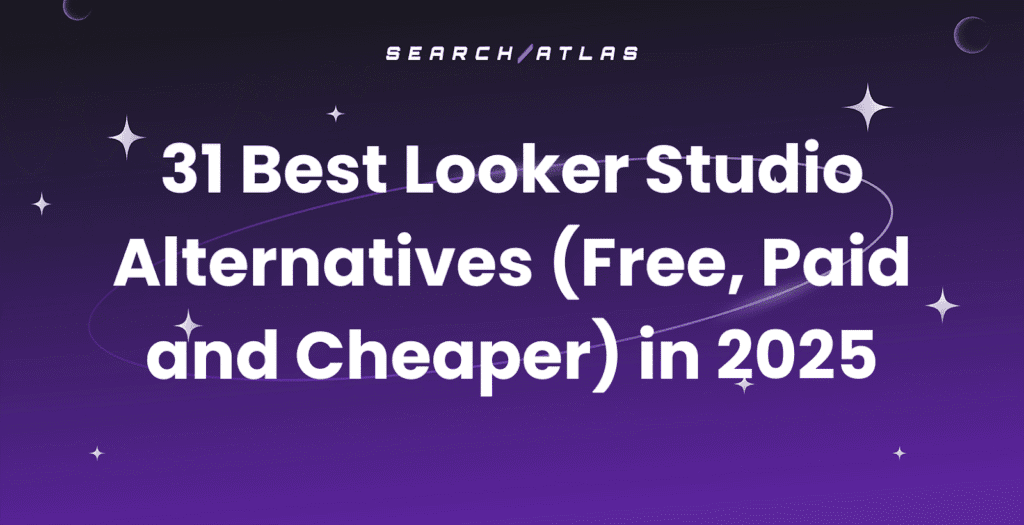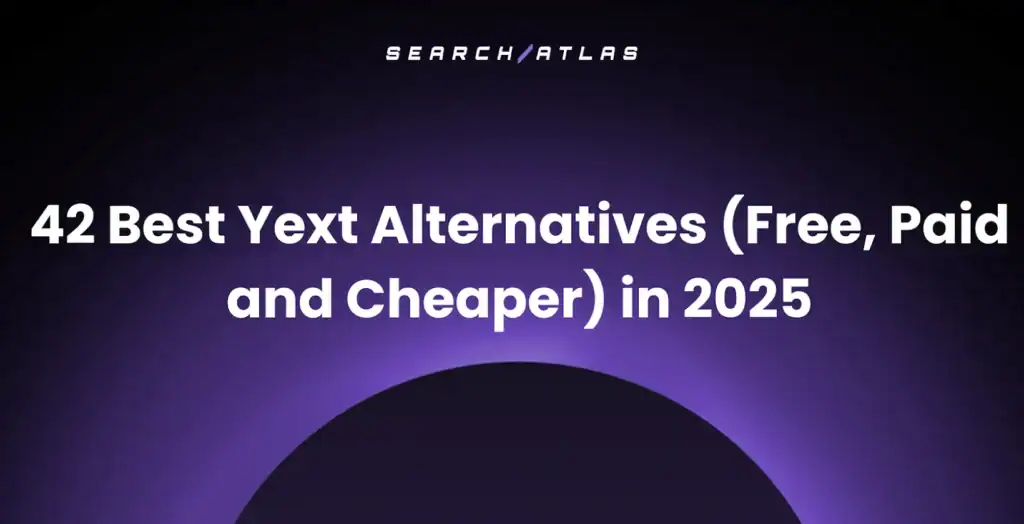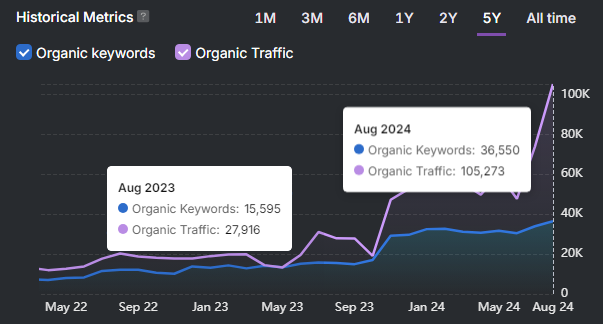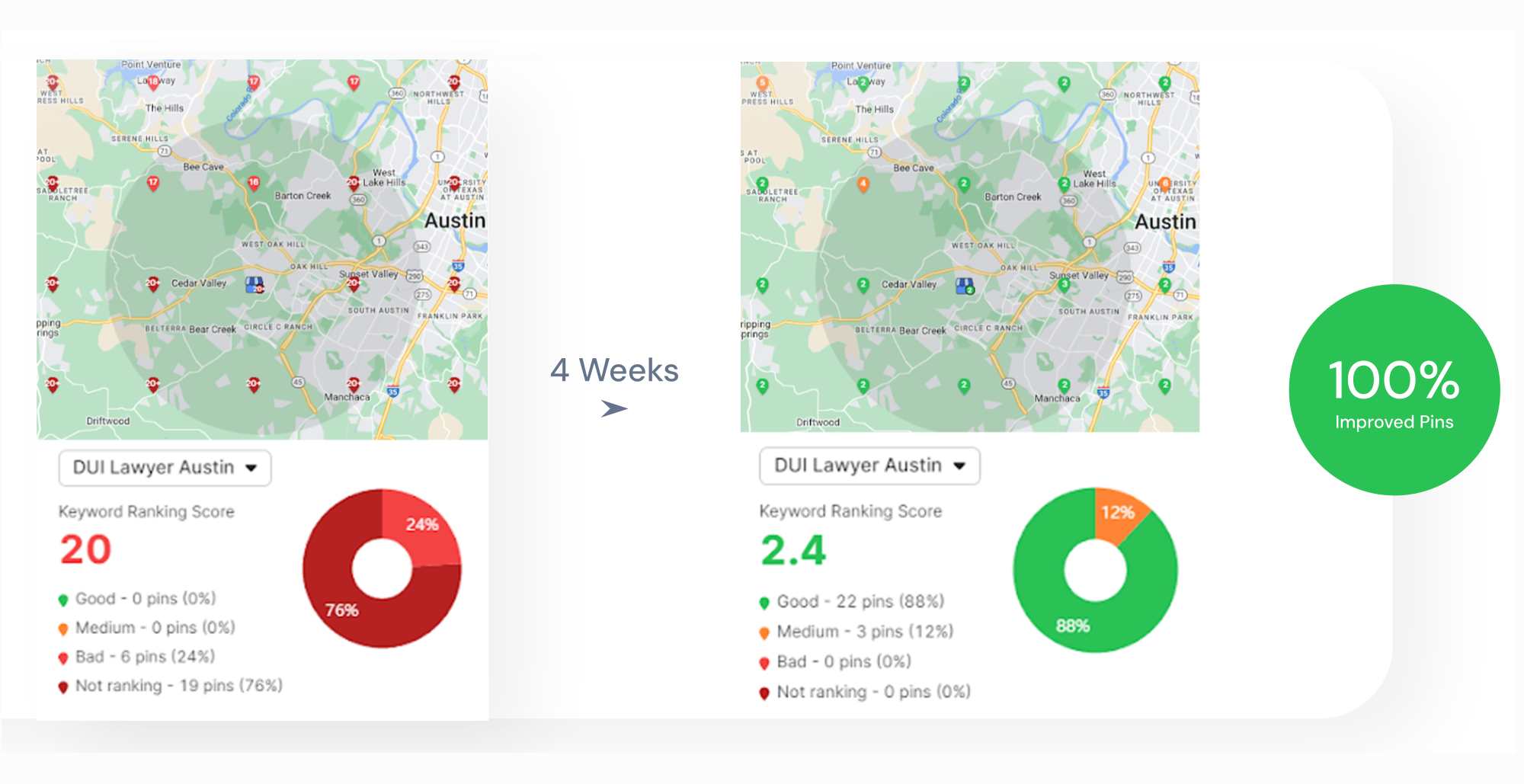The quality of content refers to the success, value, and usefulness of a piece of content for its intended audience. You measure it through KPIs such as engagement, readability, conversions, search intent alignment, and more.
We explore content quality, its importance, and ways and tools to measure and improve it. 📈
What Is Content Quality?
Content quality measures how effectively written material fulfills its purpose for the intended audience. Quality content delivers accurate, relevant information that provides genuine value to readers. Key elements include accuracy of facts, clarity of presentation, and engagement that maintains reader interest.
The material must be well-organized with logical flow and appropriate tone for the target audience. Quality content offers unique insights, practical solutions, or perspectives that readers cannot easily find elsewhere. It demonstrates consistency in style and messaging while meeting professional standards.

Why Is the Quality of Content Important?
The quality of content is important because it directly influences business outcomes, SEO performance, user experience, engagement, resource optimization, and legal compliance.
Business Impact and Revenue Generation
Quality content directly influences business success by driving measurable financial results across multiple areas. The business benefits of content quality are listed below.
- Boosting Conversion Rates. Well-crafted product descriptions, service explanations, and sales pages persuade visitors to make purchasing decisions more effectively than poor content.
- Reducing Customer Acquisition Costs. High-quality content attracts organic traffic through search engines, social media shares, and word-of-mouth recommendations. This decreases dependence on paid advertising and lowers customer acquisition expenses.
- Increasing Customer Lifetime Value. Quality content builds stronger relationships with customers, which leads to repeat purchases and higher lifetime value.
Search Engine Performance
Quality content improves search visibility by meeting algorithm requirements and earning prominent placement in search results. We list the SEO benefits of content quality below.
- Achieving Higher Rankings. Search engines prioritize content that demonstrates expertise, experience, authority, and trustworthiness (Google E-E-A-T).
- Maintaining Algorithm Resilience. Quality content withstands search engine updates better than low-quality alternatives.
- Earning Featured Snippets. Search engines select high-quality content for featured snippets and knowledge panels. This provides prime SERP real estate that drives significant traffic increases and establishes topic authority.
User Experience and Engagement
Quality content enhances user satisfaction by building trust, reducing bounce rates, and generating organic social media exposure. The effects of quality content on user experience and engagement are listed below.
- Building Trust. Quality content establishes credibility through accurate information, professional presentation, and consistent value delivery.
- Reducing Bounce Rates. Engaging, well-structured content keeps visitors on websites longer and encourages exploration of additional pages. To search engines, this signals well-satisfied user intent.
- Generating Social Sharing. People share content they find valuable, interesting, or entertaining. Social sharing expands reach without additional marketing investment.
Cost Efficiency and Resource Optimization
Quality content maximizes investment returns by providing long-term value, reducing operational expenses, and serving multiple marketing functions simultaneously. Key efficiency benefits of quality content are listed below.
- Creating Evergreen Assets. Quality content continues generating traffic, leads, and sales months or years after publication.
- Reducing Support Costs. Comprehensive, clear content answers customer questions proactively, decreasing support ticket volume and call center demands.
- Maximizing Marketing Efficiency. High-quality content serves multiple marketing purposes including SEO, lead generation, customer education, and brand building. This maximizes return on investments in content creation.
Regulatory and Legal Compliance
Quality content protects businesses from legal risks while maintaining professional standards required in regulated industries.
- Mitigating Legal Risks. Accurate, compliant content reduces legal exposure from false claims, misleading information, or regulatory violations by catching potential issues before publication.
- Meeting Professional Standards. Industries with strict communication requirements (healthcare, finance, legal) require precise, accurate information to maintain professional credibility and regulatory compliance.
How to Measure the Quality of Content
To measure the quality of content, evaluate for metrics and characteristics listed below.
Readability Assessment
Text readability determines how easily audiences understand content. Evaluate grade level requirements, sentence length, and vocabulary complexity to ensure content matches the target audience. Evaluate it by using readability tools.
Search Intent Alignment
Content alignment with search intent determines whether material satisfies user queries and search engine expectations. Google Search Console provides query data showing which search terms drive traffic to specific pages, revealing intent matches and gaps. To measure keyword intent satisfaction, track click-through rates from search results and time spent on page.
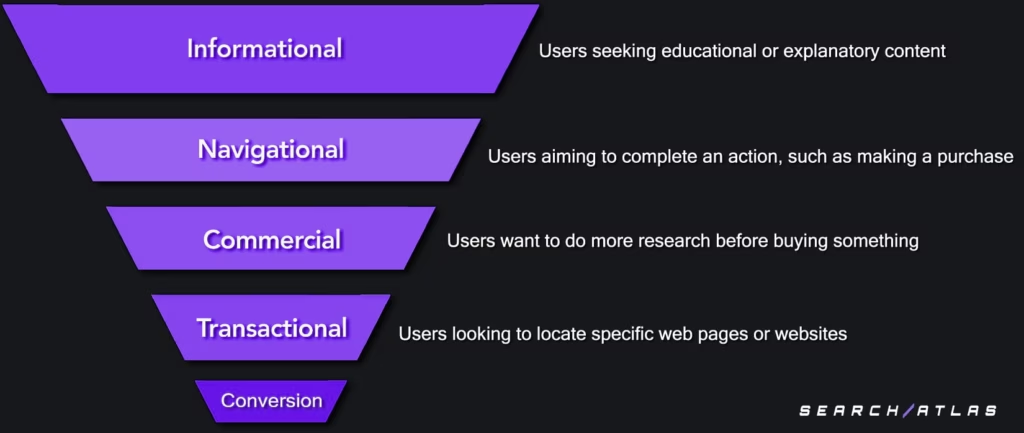
Search Atlas Keyword Research Tools categorize keywords by search intent. The types of search intent are listed below.
- Informational Search Intent. It refers to when someone looks for knowledge or answers. The goal is to learn something, not to buy or take action. These searches often start with questions like “how,” “what,” or “why.”
- Navigational Search Intent. It means the user wants to find a specific website or page. The person already knows where they want to go and uses search to get there, such as typing “Facebook login” or “YouTube.”
- Transactional Search Intent. It shows the person is ready to act, usually to make a purchase or sign up. Transactional terms often include words like “buy,” “discount,” or “free trial.” These terms are known as high-intent keywords.
- Commercial Search Intent. It describes when someone is researching products or services before making a decision. The goal of commercial search intent is to compare options, read reviews, or find the best value.
User Engagement Metrics
Engagement metrics reveal how effectively content captures and maintains audience attention. Get detailed engagement metrics by combining Google Analytics (GA4), Google Tag Manager (GTM), and your content management system (CMS). The most relevant engagement metrics are explained below.
- Time on Page. It measures how long a user stays on a page before leaving or moving to another. Longer time on page usually means the content holds attention and meets the user’s needs.
- Bounce Rate. It shows the percentage of visitors who leave after viewing only one page. A high bounce rate often signals poor content relevance or user experience, although context matters—some pages serve their purpose quickly.
- Scroll Depth. It tracks how far users scroll down a page. Deeper scrolling suggests stronger interest and better content flow.
- Pages per Session. It counts how many pages a visitor views during one visit. A higher number often means the content encourages further exploration.
- Social Sharing Rates. They reflect how often users share content on platforms like Facebook, LinkedIn, or X (Twitter).
- Comment Volume. It indicates how many users leave comments or engage in discussion.
- Return Visitor Percentages. They show how many users come back to the site after their first visit.
Content Depth and Comprehensiveness
Content depth measures how completely the material addresses topics and provides value to readers. To ensure content depth, follow the steps listed below.
- Create topical maps and content plans that address all relevant subtopics, questions, and user concerns within the subject area. Use a Content Planner Tool.
- Analyze internal linking structures to ensure content connects related topics effectively.
- Use content audit tools to identify gaps, orphaned pages, and opportunities for topic expansion.
Information Gain Assessment
Information gain measures the unique value content provides beyond existing resources on the same topic. Evaluate original research inclusion, expert interviews, case studies, and proprietary data that distinguish content from competitors. Track user feedback, comments, and questions to identify areas where content provides insufficient information. This helps you avoid creating thin content.
Conversion and Goal Achievement
Conversion tracking reveals how effectively content drives desired user actions and supports business objectives. Google Analytics goal setup measures specific conversions. Track click-through rates to related content and internal link performance. Monitor indirect conversions where content contributes to multi-touch customer journeys.
Commonly measured specific conversions are listed below.
- Email signups
- Download completions
- Contact form submissions
- Purchase initiations from content pages
Accessibility and Inclusivity Evaluation
Accessibility assessment ensures content serves users with diverse abilities and technical limitations. Evaluate alt text presence and quality for all images, ensuring descriptions convey essential information for screen reader users. Review heading structure hierarchy (H1-H6) for logical organization that supports navigation tools. Test color contrast ratios meeting WCAG guidelines. Verify that the content is functional for colorblind users.
Content Originality and Uniqueness
Originality assessment protects against duplicate content penalties while ensuring content provides distinct value in crowded topic spaces. Run plagiarism detection tools to identify unintentional duplication and ensure proper attribution for referenced materials. Evaluate unique angle development, personal experiences, and original research that differentiate content from competitors.
Competitor Benchmarking Analysis
Competitive analysis provides context for content quality standards and identifies improvement opportunities within specific industry niches. Competitor analysis tools help identify top-performing content for target keywords, revealing successful formats, lengths, and structural approaches. Compare content depth, visual element usage, internal linking patterns, and update frequencies against leading competitors. Analyze competitor social sharing performance, backlink acquisition, and blog engagement.
Content Structure and Scannability
Content structure evaluation ensures information remains digestible and navigable for online users. To evaluate content structure, mind the following steps. First, assess website heading and subheading usage frequency to ensure major topics receive clear section breaks. Second, evaluate bullet point and numbered list implementation. And third, review white space distribution, paragraph length consistency, and visual element placement.
What Tools Can You Use to Measure and Fix the Quality of Your Content?
There are various tools you can use to measure the quality of your content. We list and explain 4 efficient tools for measuring content quality below.
- Scholar
- On-page audit tools
- AI assistants
- Reporting tools
Scholar
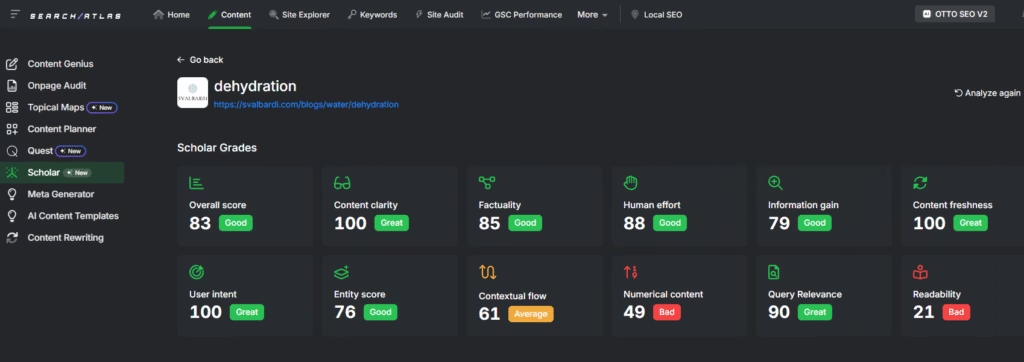
Scholar is a Search Atlas tool designed for evaluating content quality in the same way that Google does. We created Scholar through reverse-engineering Google’s hidden search factors and testing it on a vast amount of content. The tool assesses your content and compares it to top-ranking pages.
The search factors and content quality metrics are listed below.
- Content Clarity. The metric tests how clearly the page communicates its message. It checks sentence structure, reading level, and flow from idea to idea.
- Factuality. The metric measures how well the content reflects accurate knowledge. It checks whether the language and concepts show topic expertise.
- Human Effort. The metric evaluates signs of originality and human care. It looks for thoughtful structure, tone, and word choice.
- Information Gain. The metric identifies whether the page brings new insights. It lowers the score if the content repeats existing information without depth.
- User Intent Alignment. The metric analyzes whether the page matches searcher goals. It marks down pages that miss expected formats like comparisons or guides.
- Entities. The metric checks for relevant concepts tied to the topic. It uses Google’s Knowledge Graph to detect missing semantic connections.
- Contextual Flow. The metric ensures a logical structure across sections. It highlights weak flow when subtopics appear out of place.
- Numerical Score. The metric reviews how clearly and accurately the page uses numbers. It checks whether data supports the main argument.
- Query Relevance. The metric assesses the match between keyword, URL, title, and headings. It looks for strong alignment to improve search clarity.
- Readability. The metric analyzes content complexity and reading ease. It scores lower when structure and vocabulary block understanding.
- Content Freshness. The metric reviews dates, citations, and signals of recency. It flags outdated material that reduces current value. It helps detect content decay.
Onpage Audit Tool
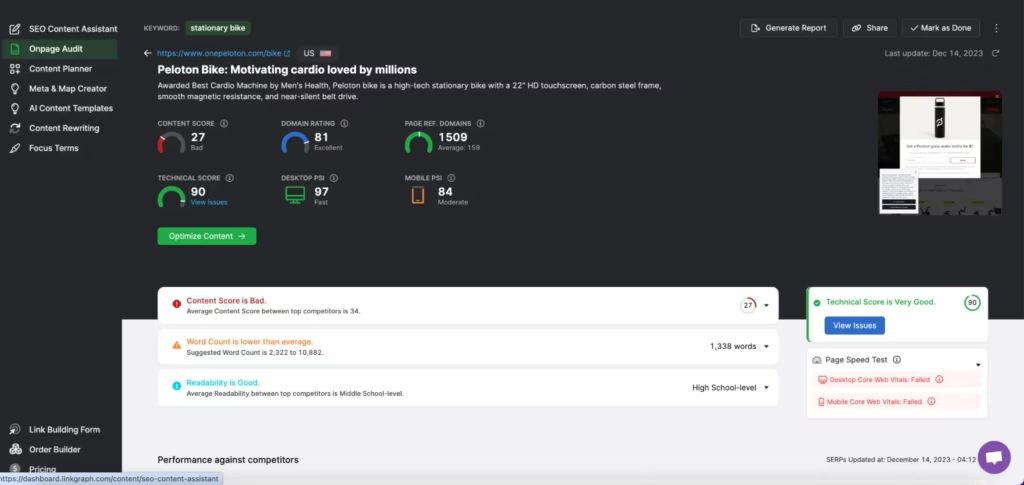
The Search Atlas On-Page Audit Tool is a comprehensive SEO analysis tool designed to evaluate and enhance the performance of individual web pages. It focuses on key areas that are listed below.
- Content Scoring. See how the page scores for readability, word count, topical terms, page structure, and multiple keywords. Compare the scores to competitors.
- Links. View the number of referring domains along with internal and external links.
- Technical Scoring. Review meta tags, schema, rich media, and other technical factors that affect indexing and crawlability.
- Competitor Analysis. Evaluate competitors’ website authority and on-page content quality. It is an essential part of every content audit.
- Recommended Actions. Follow suggestions to add missing keywords, internal links, tags, and structural elements to raise your content score.
- 1-Click Optimization. Send the page to the SEO Content Assistant to improve content quality and search performance instantly.
AI Assistant OTTO SEO
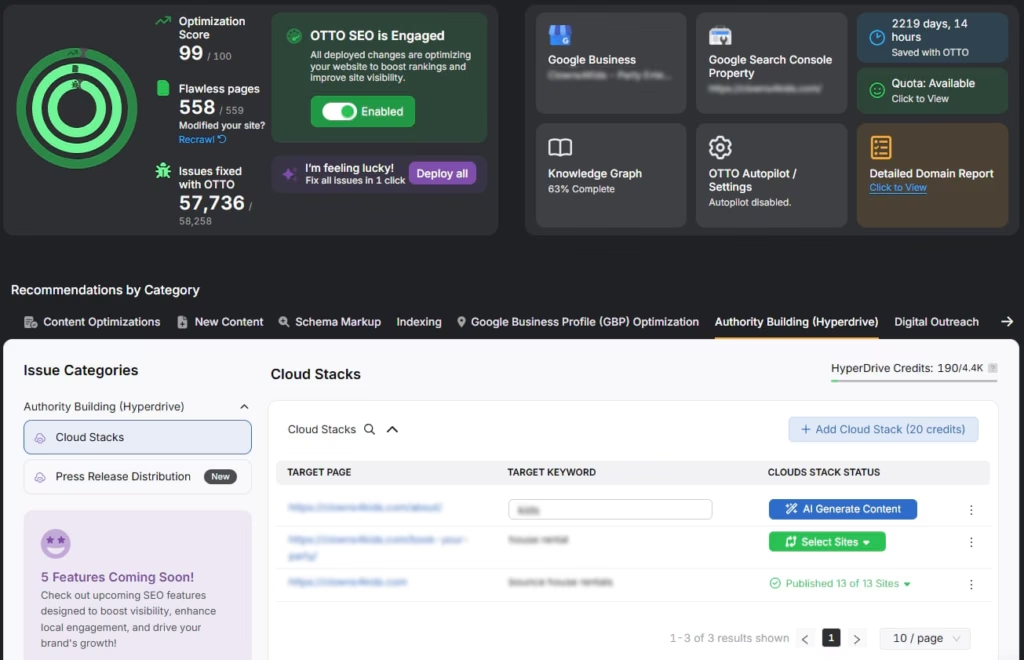
OTTO SEO is an AI-powered SEO automation tool designed to enhance website optimization efforts. By integrating the OTTO pixel into your website, OTTO SEO automates various SEO tasks, including content optimization and monitoring.
The methods OTTO SEO uses to evaluate and improve content quality are listed below.
- Semantic SEO Enhancements. By incorporating NLP entities and optimizing meta tags, OTTO SEO ensures that your content aligns with search intent and semantic relevance.
- Content Performance Monitoring. The tool tracks key metrics such as engagement rates and keyword rankings.
- Tailored Recommendations. Based on data from Google Search Console (GSC) and the Search Atlas Holistic SEO blueprint, OTTO SEO offers customized suggestions to refine content strategy and execution. It speeds up optimization significantly when combined with content analysis tools.
Reporting Tools
Reporting tools measure content quality by centralizing and visualizing performance data. These tools track how content performs across key metrics (engagement, traffic, conversions) so teams are able to make informed decisions.
They matter more when they include Google Analytics and Google Search Console integrations. These integrations help content evaluation for reasons listed below.
- They unify metrics from behavioral and search sources. GA reveals how users interact with the content while GSC shows how often the content appears in search, what keywords trigger impressions, and what drives clicks.
- They identify weak points across both user experience and search performance.
- They tie SEO efforts to real outcomes like traffic quality, engagement, and conversions.
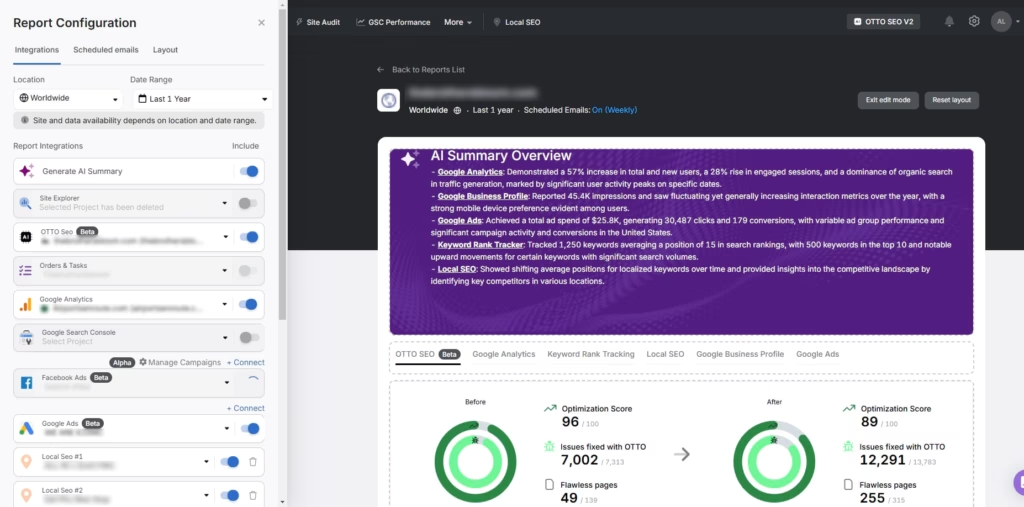
Search Atlas Reporting Tools offer integrations with GSC, GA4, and other marketing data sources such as Google Ads and Facebook Ads. Search Atlas SEO reporting tools offer automated scheduling. Automated scheduling has several benefits which are listed below.
- It keeps stakeholders informed with fresh insights without manual effort.
- It supports routine audits that catch quality decay over time.
- It enables faster decision-making by delivering data consistently (daily, weekly, monthly, or custom-range).
Improve Content Quality Based on Clear, Tested Data
Data-driven content optimization enables strategic decision-making. By consistently measuring engagement metrics, user behavior patterns, and conversion rates, marketers identify what truly resonates with their audience.
This systematic approach ensures content quality improvements are grounded in evidence rather than assumptions. The approach leads to higher engagement, better user satisfaction, and measurable business results.
Search Atlas tools give you the data you need. Test Search Atlas tools with no commitment with a 7-day FREE trial.


